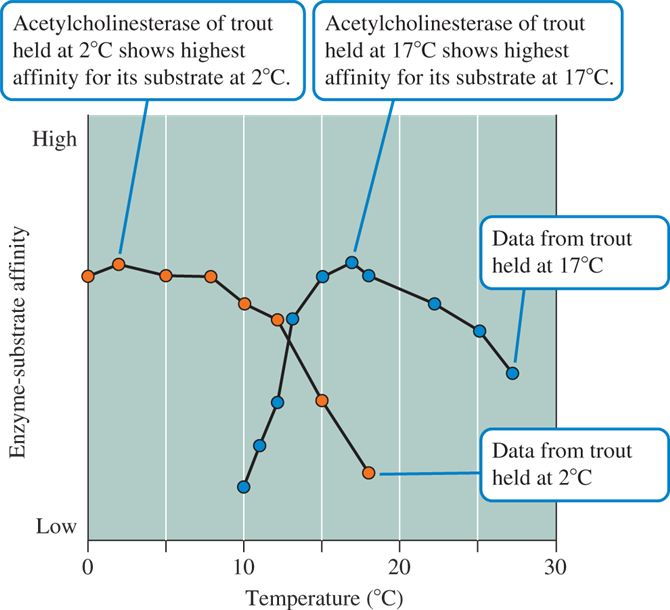 |
| Previous Image | Next Image |
| Description: Let's begin our discussion of temperature and an organism's overall performance by looking at a simpler situation; the influence of temperature on enzyme function. Because enzymes must match the shape of the substrate upon which they act, they must assume a specific shape for proper function. Most enzymes have a rigid, predictable shape at low temperatures, but rates of chemical reactions tend to be low at these low temperatures. Also, rigidity does not help an enzyme perform its function. Their functioning often depends upon flexibility, the ability to assume another shape after binding with the substrate. Enzymes have greater flexibility at higher temperatures, but excessively high temperatures destroy their shape. Temperatures at either extreme thus impair the functioning of enzymes. Enzymes usually work fastest in some intermediate range of temperatures, where they retain both proper shape and sufficient flexibility. In other words, there is usually some optimal range of temperatures for most enzymes. How might you determine the optimal temperature for an enzyme? One way is to determine the minimum concentration of substrate required for an enzyme to work at a particular rate. If this concentration is low, the enzyme is performing well, that is, the enzyme has a high affinity for the substrate. The affinity of an enzyme for its substrate is one measure of its performance. Peter Hochachka, formerly of the University of British Columbia, was one of Canada's leading zoologists. He had a diverse research program, with a particular emphasis on adaptational biochemistry. One line of his research program involved the influence of temperature on the activity of acetylcholinesteras e, an enzyme produced at the synapse between neurons. This enzyme promotes the breakdown of the neurotransmitter acetylcholine to acetic acid and choline and so turns off neurons, a process critical for proper neural function. In one study, Baldwin and Hochachka (1970) found that rainbow trout, Oncorhynchus mykiss, produce two forms of acetylcholinesteras e. One form has highest affinity for acetylcholine at 2°C, that is, at winter temperatures. However, the affinity of this enzyme for acetylcholine declines rapidly above 10°C. The second form of acetylcholinesteras e shows highest affinity for acetylcholine at 17°C, at summer temperatures. However, the affinity of this second form of acetylcholinesteras e falls off rapidly at both higher and lower temperatures. In other words, the optimal temperatures for the two forms of acetylcholinesteras e are 2°C and 17°C
Picture Stats: Views: 2254 Filesize: 55.65kB Height: 610 Width: 670 Source: https://biology-forums.com/index.php?action=gallery;sa=view;id=1635 |
